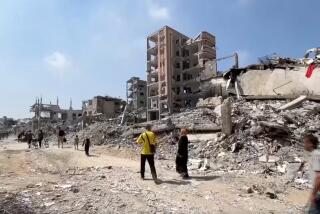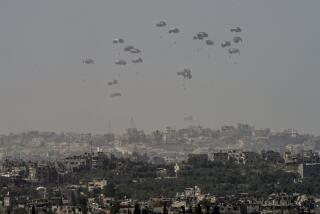1,000 TROOPS STRIKE HEART OF BAGHDAD
- Share via
BAGHDAD — In fierce, daylong fighting Tuesday, 1,000 American and Iraqi troops assisted by U.S. attack helicopters and warplanes battled gunmen in a Sunni Arab neighborhood of downtown Baghdad, killing at least 51 suspected militants, Iraqi officials said.
The offensive, which resulted in the heaviest fighting in the capital in months, came in response to a buildup of insurgents in the Haifa Street neighborhood next to the highly fortified Green Zone government complex. Sunni gunmen had erected fake checkpoints in recent days, residents said, in one case pulling passengers from a minibus, killing them and stringing their bodies from utility poles.
American airstrikes continued throughout the day, plumes of smoke rising over the neighborhood as explosions and gunfire echoed in the streets.
Snipers fought back from high-rise apartment buildings, supporting fellow insurgents armed with machine guns, rocket-propelled grenades and mortar launchers.
Troops went door to door searching for militants. No U.S. or Iraqi troops were killed, nor were any civilians, Iraqi officials said.
The fighting, which broke out a day before President Bush was expected to announce the deployment of at least 20,000 more U.S. troops to Iraq, underscored some of the challenges such an escalation in Baghdad could face.
Some military commanders believe violence would increase if more American troops entered the capital.
Army Gen. John P. Abizaid, who will retire soon as the top U.S. commander in the Mideast, has opposed troop increases in the past partly because he believes they offer more targets for insurgents.
In his view, additional troops can add to a feeling of chaos rather than foster a sense of security if insurgents set off bombs every time an American convoy moves through.
Advocates of an increase maintain that a larger U.S. force, especially in urban areas such as Baghdad, could deter insurgents and Shiite Muslim militias through their visibility and quick response to hostile action.
Last week, Iraqi Prime Minister Nouri Maliki and a top U.S. military commander on the ground announced a new plan to secure the capital.
But past operations, including the most recent, launched in June, have failed, in part because rebels tend to regroup elsewhere and return once the troops have left, critics say.
The Haifa Street neighborhood, where Saddam Hussein once gave away real estate to army officers and party officials, emerged after the U.S.-led invasion in 2003 as a place of visible and widespread resistance. For a while, locals flew black flags, declaring “holy war” against the Americans.
Progress had been made
Then known as “Purple Heart Boulevard” because of the high number of U.S. casualties, Haifa Street was declared a success story by Bush in late 2005 after elite Iraqi security forces brought down the number of attacks.
At the time, American and Iraqi troops had established a presence in the neighborhood, prompting its cleanup. Potholes from bombs and mortar rounds were filled and the violence ebbed.
Iraqi government forces were left responsible for maintaining order in the neighborhood, but they were ineffective on their own.
During the last year, rebels regrouped in and around the three-mile stretch of road that cuts through central Baghdad. Last week, police recovered 27 bodies dumped near a cemetery as militants flooded the neighborhood from other parts of the city.
On Sunday, a security guard said a sniper holed up at a local mosque had killed two of the guard’s colleagues.
The following day, gunmen roamed the streets, distributing leaflets threatening to kill anyone who might enter the area, another witness said.
When Iraqi security forces tried to clear out the rebels, the rebels fought them off, Iraqi officials and residents said.
Shortly before dawn Tuesday, U.S. and Iraqi troops swarmed the neighborhood, closing it off. Soon the streets were deserted as militants took up positions and residents retreated indoors.
U.S. aircraft then targeted gunmen in the streets and snipers on roofs, witnesses said.
‘Torn to pieces’
“I saw with my own eyes a vehicle filled with gunmen carrying different weapons and rocket launchers,” said Abdullah Jassim, one of the few Shiites in the area. “A few moments later, the car was torn to pieces by an airstrike, setting the vehicle ablaze and killing all those who were inside.”
Jassim, 37, a shop owner who decided to leave the neighborhood as the fighting intensified Tuesday, said Americans bombed at least one well-known hide-out used by insurgent snipers.
On Tuesday, Lt. Col. Scott Bleichwehl, a U.S. military spokesman, said the joint campaign along Haifa Street would “continue until this area is secured.”
Iraqi government spokesman Ali Dabbagh, meanwhile, expressed support for more American troops in Iraq.
“The goal is to protect Baghdad and other areas,” he said. “If this is going to be achieved by an increase in friendly coalition forces, we have no objection.”
The civil war between Sunnis and Shiites, combined with the insurgency directed at the Americans, has made the streets of the capital increasingly lawless and killed tens of thousands of civilians.
A 43-year-old Sunni woman who asked to be identified as Umm Wissam said she feared the gunmen and had stopped sending her children to school. The raid Tuesday made her feel even less safe.
‘I will leave Haifa Street’
“We don’t know if we will survive this,” she said. “When this operation is finished, I will leave Haifa Street for good. We can’t live here anymore.”
Throughout the morning Tuesday, residents could hear the thunderous explosions of the aerial assault.
“I said to myself, ‘We are going to die,’ ” shop owner Jassim said. “Our houses are kind of old, and they can be destroyed easily.”
He left out of fear that the militants might kill him and his family.
“We couldn’t leave in the morning because the clashes were very intense,” he said.
Eventually they made it to a relative’s house in another part of town.
“We’re really afraid,” said Raad Radhi, 50, a Sunni merchant. “All the windows in our buildings and the neighboring ones were completely smashed because of the bombings.”
In one apartment, Radhi said, troops harassed an elderly Syrian teacher living with his son, a college student.
Maj. Gen. Ibrahim Shaker, a Defense Ministry spokesman, said 51 suspected insurgents were killed and 21 others, including three Syrians and a Sudanese, were captured.
Violence continued elsewhere in Iraq. At least 40 bodies were found around Baghdad. North of the capital, in troubled Diyala province, U.S. forces pounded palm groves and canals with artillery and gunfire as a joint offensive with Iraqi troops entered its sixth day.
Tunnels and canals
In that operation, 1,000 troops have swept over about 75 square miles of farmland and isolated hamlets, zeroing in on a network of tunnels, spider holes and canals they say has become a haven and training ground for Sunni rebels.
At least 74 suspected insurgents have been killed since the offensive began, the U.S. military said, and troops have found at least 14 weapons caches.
“We could stay here for eternity,” said Lt. Col. Andrew Poppas, commander of the 5th Squadron, 73rd Cavalry, as he toured the battlefield smoking a cigar. “We’ve got the capability to wait out anybody.”
The military said an American soldier assigned to the 3rd Heavy Brigade Combat Team, 1st Cavalry Division, died Tuesday of gunshot wounds suffered in the fighting in Diyala.
Near the city of Kut, a shepherd was killed when he stepped on a land mine close to the Iranian border. Another man was found slain, handcuffed and blindfolded, in the river near the city.
Because of the bloodshed, Iraqis are fleeing their homes in record numbers. As many as one in eight have been displaced, making the refugee problem in the region the biggest in almost 60 years, according to the United Nations.
*
Times staff writers Saif Hameed and Salar Jaff in Baghdad, Alexandra Zavis in Diyala and Julian E. Barnes in Washington contributed to this report.
More to Read
Sign up for Essential California
The most important California stories and recommendations in your inbox every morning.
You may occasionally receive promotional content from the Los Angeles Times.









